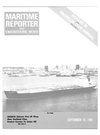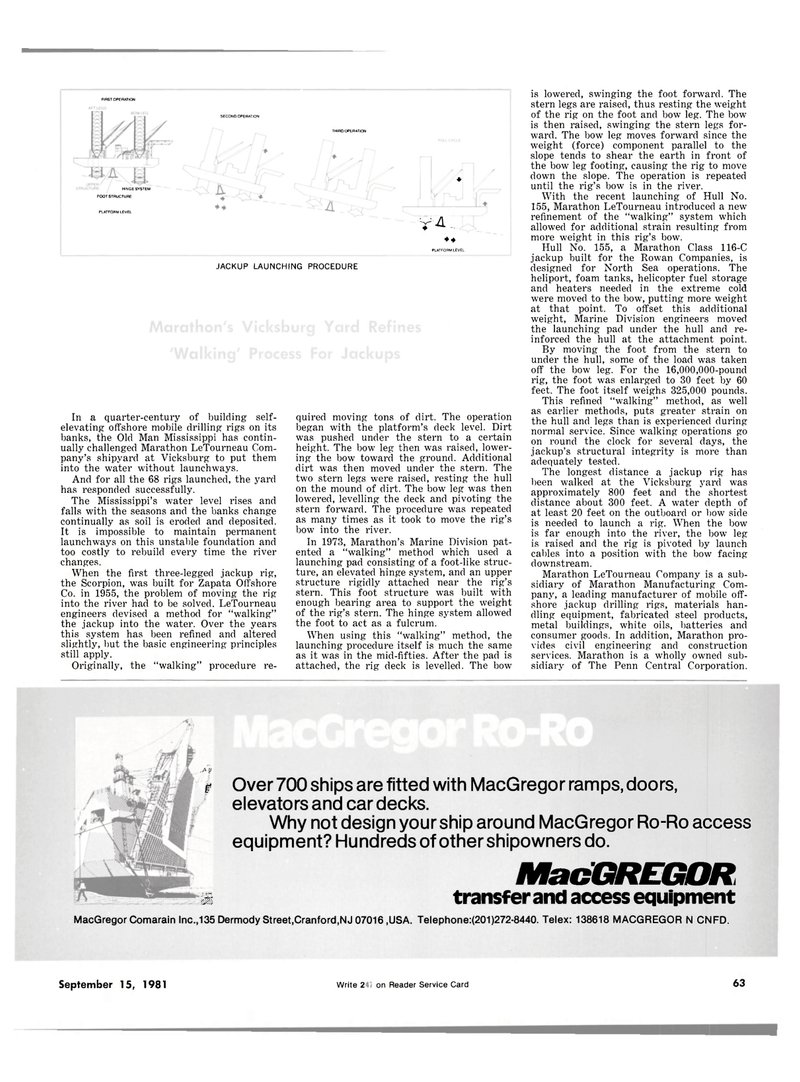
Page 4th Cover: of Maritime Reporter Magazine (September 15, 1981)
Read this page in Pdf, Flash or Html5 edition of September 15, 1981 Maritime Reporter Magazine
FIRST OPERATION
SECOND OPERATION
THIRD OPERATION
HINGE SYSTEM
FOOT STRUCTURE
PLATFORM LEVEL • yA ___ **
PLATFORM LEVEL
JACKUP LAUNCHING PROCEDURE
In a quarter-century of building self- elevating offshore mobile drilling rigs on its banks, the Old Man Mississippi has contin- ually challenged Marathon LeTourneau Com- pany's shipyard at Vicksburg to put them into the water without launchways.
And for all the 68 rigs launched, the yard has responded successfully.
The Mississippi's water level rises and falls with the seasons and the banks change continually as soil is eroded and deposited.
It is impossible to maintain permanent launchways on this unstable foundation and too costly to rebuild every time the river changes.
When the first three-legged jackup rig, the Scorpion, was built for Zapata Offshore
Co. in 1955, the problem of moving the rig into the river had to be solved. LeTourneau engineers devised a method for "walking" the jackup into the water. Over the years this system has been refined and altered slightly, but the basic engineering principles still apply.
Originally, the "walking" procedure in- quired moving tons of dirt. The operation began with the platform's deck level. Dirt was pushed under the stern to a certain height. The bow leg then was raised, lower- ing the bow toward the ground. Additional dirt was then moved under the stern. The two stern legs were raised, resting the hull on the mound of dirt. The bow leg was then lowered, levelling the deck and pivoting the stern forward. The procedure was repeated as many times as it took to move the rig's bow into the river.
In 1973, Marathon's Marine Division pat- ented a "walking" method which used a launching pad consisting of a foot-like struc- ture, an elevated hinge system, and an upper structure rigidly attached near the rig's stern. This foot structure was built with enough bearing area to support the weight of the rig's stern. The hinge system allowed the foot to act as a fulcrum.
When using this "walking" method, the launching procedure itself is much the same as it was in the mid-fifties. After the pad is attached, the rig deck is levelled. The bow is lowered, swinging the foot forward. The stern legs are raised, thus resting the weight of the rig on the foot and bow leg. The bow is then raised, swinging the stern legs for- ward. The bow leg moves forward since the weight (force) component parallel to the slope tends to shear the earth in front of the bow leg footing, causing the rig to move down the slope. The operation is repeated until the rig's bow is in the river.
With the recent launching of Hull No. 155, Marathon LeTourneau introduced a new refinement of the "walking" system which allowed for additional strain resulting from more weight in this rig's bow.
Hull No. 155, a Marathon Class 116-C jackup built for the Rowan Companies, is designed for North Sea operations. The heliport, foam tanks, helicopter fuel storage and heaters needed in the extreme cold were moved to the bow, putting more weight at that point. To offset this additional weight, Marine Division engineers moved the launching pad under the hull and re- inforced the hull at the attachment point.
By moving the foot from the stern to under the hull, some of the load was taken off the bow leg. For the 16,000,000-pound rig, the foot was enlarged to 30 feet by 60 feet. The foot itself weighs 325,000 pounds.
This refined "walking" method, as well as earlier methods, puts greater strain on the hull and legs than is experienced during normal service. Since walking operations go on round the clock for several days, the jackup's structural integrity is more than adequately tested.
The longest distance a jackup rig has been walked at the Vicksburg yard was approximately 800 feet and the shortest distance about 300 feet. A water depth of at least 20 feet on the outboard or bow side is needed to launch a rig. When the bow is far enough into the river, the bow leg is raised and the rig is pivoted by launch cables into a position with the bow facing downstream.
Marathon LeTourneau Company is a sub- sidiary of Marathon Manufacturing Com- pany, a leading manufacturer of mobile off- shore jackup drilling rigs, materials han- dling equipment, fabricated steel products, metal buildings, white oils, batteries and consumer goods. In addition, Marathon pro- vides civil engineering and construction services. Marathon is a wholly owned sub- sidiary of The Penn Central Corporation. imi r Over 700 ships are fitted with MacGregor ramps, doors, elevators and car decks.
Why not design your ship around MacGregor Ro-Ro access equipment? Hundreds of other shipowners do.
MacGREGOR p transfer and access equipment
MacGregor Comarain Inc.,135 Dermody Street,Cranford,NJ 07016 ,USA. Telephone:(201)272-8440. Telex: 138618 MACGREGOR N CNFD.
September 15, 1981 Write 292 on Reader Service Card 63

 3rd Cover
3rd Cover

